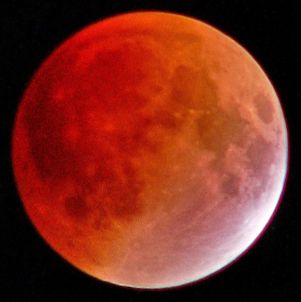Carnival of Space, That Is
This week’s Carnival of Space — that compendium of writing by various bloggers — is now up for your reading pleasure. Take a few moments to check out stories about everything from the Japan earthquake to cataclysmic variables, density waves in spiral galaxies, comet Halley, and movie reviews over at Steve’s Astro Corner.

As you’ve probably read (in breathless prose on some media sites, I’m sure), there’s a Full Moon today (March 19th). You’ve no doubt been treated to all this hype and anguish over how it’s the LARGEST FULL MOON EVAR!!! and the CLOSEST FULL MOON IN MODERN TIMES and all kinds of other hyperbolic fulminating.
Lots of people are crowing about something that isn’t all that rare… and didn’t cause the earthquakes, thank you very much.
Here’s a sanity check on the news behind the hype.
As it turns out, tonight’s Full Moon is going to be closer to us than usual, and for that reason, it’s being dubbed a “SuperMoon”. The last one THIS big was in 1993 (as you can read here at NASA’s Science News site).
But it’s not all that an unusual thing to happen. During parts of its orbit, the Moon does sometimes come closer to us than other times. As it happens, this is the closest one in less than three years. Yep, that’s right, the last “close” full Moon was in late 2008. In fact, the January 2010 Full Moon was only 20 kilometers farther away than tonight’s.
The point is, this big Full Moon that lots of mainstream media (and astrologers) are hyping isn’t so rare after all.
My fellow blogger Ian Musgrave in Adelaide, Australia, did a little nosing around to find out the truth behind the hype. He takes on some popular mythology about the Moon and all kinds of coincidental occurrences here on Earth. He also has a nice chart you can check out that shows the distances of the “close” Full Moons since 1991. There have been 21 in 20 years.
Umm… not so rare there, folks. But, that hasn’t stopped Yahoo.com, Accuweather, and other sites I used to think were credible from spouting nonsense that appears to be based on something an astrologer wrote. Do I need to point out (again) that an astrologer is not a scientist — not a lunar geologist, not an earth sciences person, not an astroNomer, and certainly not a credible expert on lunar orbits?
Look, think of the Full Moon in its orbit like a car going around an oval-shaped race course. If you stand at one end of the oval, the car is going to be close to you at least once each time it goes around. That’s called “perigee” and it’s entirely normal and nothing to start casting horoscopes over. When the car is farthest from you in the oval, it’s at apogee. Now, due to various conditions, sometimes the car gets closer to you during perigee than at other times during perigee. So, imagine that in one lap it was three meters away from you. In the next lap, it might be one centimeter closer to you. It’s perfectly normal and nothing to start reading palms about.
The Moon’s orbit is the same way, in that sometimes it’s a few percent closer to us than other times. Occasionally, that perigee time coincides with Full Moon — the phase of the Moon that occurs when the Moon is on the opposite side of Earth from the Sun, thus allowing the side facing us to be bathed in sunlight. (Perigee and Full Moon are two different things, so don’t confuse them with each other. For a more thorough discussion of Full Moon, go here. ) They are perfectly normal and nothing to start blaming the Japan earthquake on. That temblor and all the earthquakes that occur in Japan and around the Pacific Basin are due to the so-called “Ring of Fire” are due to Earth’s plate tectonics. These are natural phenomena and nothing to start blaming the Moon for.
I’m not sure why this is such a big deal, this SuperMoon thing. Is it because if an astrologer says so in flowery language that somehow looks impressive but means very little (the definition of amphigory, by the way)? If so, see the last sentence of previous paragraph. Is it because if you put the word “Super” in front of something, that makes it all magical somehow? It’s like putting “mega” in front of words. You see it all the time, particularly when somebody wants to sell you something (whether product or whack idea). “MEGA-SAVINGS ON BULK ADULT DIAPERS!” or “MEGA-SALE AT XXX AUTO DEALERSHIP!!!!! SAVE 1000’S OF $$$” (Try saying that last one out loud and it comes out as “Save one thousands of dollars!” Who talks like that? Who taught the copywriter how to punctuate?)
Now, you can take my word for it that there’s nothing magical or mysterious about the closeness of this particular Full Moon. It will look beautiful, provided you aren’t under cloudy skies. I guarantee you will (or have done so already) walk outside, look at this gorgeous Full Moon and say to yourself, “It’s wonderful, but I don’t see much difference from the other Full Moons I’ve seen.” And, you would be correct.
And, that’s the point. Last month’s Full Moon measured 33.4 arcseconds across. Tonight’s Full Moon will measure 33.7 arcseconds. It’s NOT a difference that you or me or anybody who looks at it with the old Mark I eyeballs are going to SEE. I defy you to tell me your eyes can discern that small of a difference. And furnish proof, if you do.
What I will CHALLENGE you to do is go out and look at the lovely Moon. Enjoy it. Cherish it. That’s what its’ all about in skygazing. Enjoy what you see. Any time you can step outside and enjoy a lovely moon rise is a life experience worth having!

